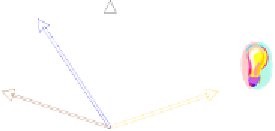Game Development Reference
In-Depth Information
Figure 2.
The reflected light that reaches the camera lens depends on the
direction of the normal to the surface (
), the vector from the studied point
to the light source (
) and the vector from the point to the camera lens (
).
θ
for perfectly specular reflections.
ϕ
is the angular difference
between the reflected beam and the camera perspective towards the object.
ϑ =
ϕ
ϑ
θ
the normal
to the surface at the point p being studied;
•
the vector
from p to the camera; and
•
the vector
from
p
to the light source.
•
Due to the difficulty of deducing the great number of parameters and variables,
one common hypothesis usually taken is to consider faces as lambertian surfaces
(only reflecting diffuse light), so as to reduce the complexity of the illumination
model. Luong, Fua and Leclerc (2002) studied the light conditions of faces to be
able to obtain texture images for realistic head synthesis from video sequences
under this hypothesis. Other reflectance models are also used (Debevec et al.,
2000), although they focus more on reproducing natural lighting on synthetic
surfaces than on understanding the consequences of the lighting on the surface,
itself. In most cases, the analysis of motion and expressions on faces is more
concerned with the effect of illumination on the facial surface studied than with
the overall understanding of the lighting characteristics. A fairly extended
approach to appreciate the result of lighting on faces is to analyze illumination by
trying to synthetically reproduce it on the realistic 3D-model of the user's head.
Phong's reflection model is the 3D shading model most heavily used to assign
shades to each individual pixel of the synthetic face. It is characterized by
simplifying second-order reflections, introducing an ambient reflection term that
simulates the sparse (diffuse) reflection coming from sources whose light has
been so dispersed that it is very difficult to determine its origin. Whether the
lighting synthesis is used to compensate the image input (Eisert & Girod, 2002)



















































Search WWH ::

Custom Search